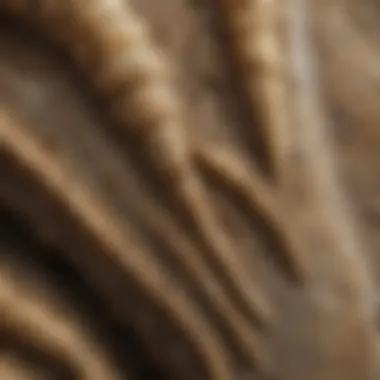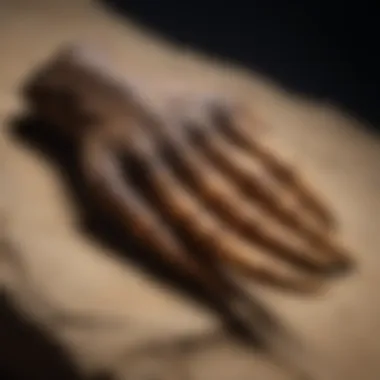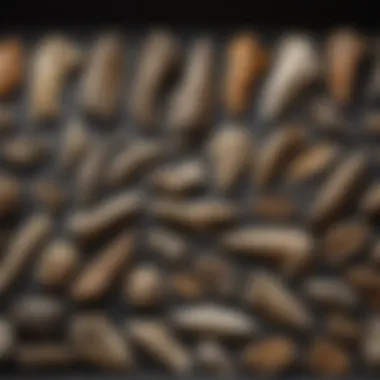Unlocking the Enigma of Raptor Claw Fossils: A Collector's Guide to Ancient Treasures


Rock and Fossil Identification
In the realm of raptor claw fossils, understanding rock and fossil identification is paramount to discerning collectors. Various types of rocks can contain these prized fossils, ranging from sedimentary to metamorphic rocks. Fossil characteristics such as texture, color, and composition play a vital role in distinguishing raptor claw fossils from other remnants. Collectors must utilize tools like magnifying lenses, UV lights, and rock hammers for successful identification.
Collecting Tips and Techniques
For aspiring collectors eager to delve into the world of raptor claw fossils, adopting best practices is essential. Locating prime collecting sites often involves researching geological maps and actively seeking locations with known fossil deposits. Safely extracting specimens requires precision tools like chisels and brushes to avoid damaging the delicate fossils buried within rocky crevices.
Preservation and Display
Preserving raptor claw fossils is a delicate art that necessitates specialized techniques. Various preservation methods, including consolidants and protective coatings, help maintain the integrity of these ancient treasures. Proper storage in archival-quality containers ensures longevity, while creative display ideas such as mounting fossils in shadow boxes or creating museum-like exhibits can showcase these fossils in all their splendor.
Geological Insights
Unlocking the geological secrets encapsulated within raptor claw fossils provides enthusiasts with a deeper appreciation for the Earth's history. Understanding different geological formations and the processes that lead to fossilization enhances collectors' knowledge of these specimens' origins. Delving into the historical significance of notable fossil discoveries offers a compelling narrative, highlighting groundbreaking research and the invaluable contributions of paleontologists to the field.
Introduction
Raptor claw fossils stand as captivating relics of an ancient world, holding a wealth of information about prehistoric creatures. In this comprehensive guide, we delve into the intriguing world of raptor claw fossils, exploring their significance, rarity, and enduring allure to collectors. From the meticulous formation process to their distinctive features and profound significance in the realm of paleontology, raptor claw fossils offer enthusiasts a glimpse into a bygone era. This article sheds light on the essence of raptor claw fossils, providing valuable insights for both seasoned collectors and budding enthusiasts.
Understanding Raptor Claw Fossils
Formation Process
The Formation Process of raptor claw fossils unveils the intricate journey of fossilization, where organic material transforms into mineralized remains over millennia. This meticulous process provides a unique window into the ancient past, preserving intricate details of raptor claws for enthusiasts to uncover. The key characteristic of the Formation Process lies in its ability to capture delicate structures with remarkable precision, making it a popular choice for collectors seeking authenticity in their fossil acquisitions. Despite its time-consuming nature, the Formation Process ensures the longevity and integrity of these ancient treasures, adding value to their significance within the context of paleontology.
Distinctive Features
Raptor claw fossils boast distinctive features that set them apart within the fossil realm. From razor-sharp talons to unique curvature, these fossils bear the unmistakable imprints of their prehistoric owners. The key characteristic of their Distinctive Features lies in their ability to offer valuable insights into the behavior and physiology of raptors, captivating collectors with their intricacy and historical significance. Despite some challenges in preservation due to their delicate nature, the distinct features of raptor claw fossils enhance their desirability among fossil enthusiasts.
Significance in Paleontology
The Significance in Paleontology of raptor claw fossils transcends mere artifacts, serving as crucial pieces in reconstructing the evolutionary puzzle of ancient predators. These fossils provide vital clues about raptor behavior, hunting techniques, and adaptations that shaped their existence. The key characteristic of their Significance in Paleontology lies in their role as tangible evidence of the past, enabling researchers to unravel mysteries surrounding these formidable creatures. Despite some interpretative challenges, the significance of raptor claw fossils in paleontology remains unparalleled, offering a gateway to understanding the evolutionary trajectory of raptors.
Appeal to Collectors
Rare Nature of Raptor Claw Fossils


Raptor claw fossils intrigue collectors with their rarity, representing elusive pieces of a distant era. Their scarcity in the fossil record adds to their allure, fetching attention from discerning collectors seeking unique specimens for their collections. The key characteristic of the Rare Nature of Raptor Claw Fossils lies in their limited availability, making them coveted acquisitions among fossil enthusiasts. While their rarity contributes to their exclusivity, it also presents challenges in sourcing authentic specimens, heightening the appeal of these ancient relics.
Historical Importance
The Historical Importance of raptor claw fossils resonates with collectors drawn to the narratives of bygone epochs. These fossils intertwine paleontological discoveries with historical contexts, connecting modern-day enthusiasts to ancient predators that once roamed the Earth. The key characteristic of their Historical Importance lies in their ability to bridge past and present, offering a tangible link to prehistoric worlds that fascinate collectors. Despite challenges in tracing their exact origins, the historical value of raptor claw fossils adds a layer of intrigue to their allure, enriching the collecting experience for enthusiasts.
Aesthetic Value
Beyond their scientific significance, raptor claw fossils possess an inherent Aesthetic Value that appeals to collectors with an eye for beauty in natural history. The intricate designs and textures of these fossils exude a certain artistic charm, making them not just scientific specimens but also visually captivating artifacts. The key characteristic of their Aesthetic Value lies in their ornamental appeal, transforming them into focal points within fossil collections. While aesthetic preferences may vary among collectors, the visual allure of raptor claw fossils remains a driving force behind their popularity in the world of fossil collecting.
Acquiring Raptor Claw Fossils
In the captivating realm of paleontology and fossil collection, the process of acquiring raptor claw fossils stands out as a pivotal step in expanding one's collection and knowledge of these ancient treasures. Understanding the importance of acquiring raptor claw fossils is essential for enthusiasts seeking to delve deeper into the world of prehistoric artifacts. This section will explore key aspects such as the rarity and value of these fossils, the ethical considerations involved in their procurement, and the joys of adding such rare specimens to one's collection.
Legal Considerations
Regulations on Fossil Collection
Delving into the specific realm of regulations surrounding fossil collection sheds light on the meticulous framework that governs the acquisition of raptor claw fossils. Compliance with these regulations not only ensures the ethical sourcing of fossils but also contributes to the preservation of geological heritage. Understanding the nuances of these regulations is imperative for collectors to engage in responsible fossil procurement practices that align with legal mandates and ethical standards.
Ethical Sourcing Practices
Exploring the realm of ethical sourcing practices in fossil collection reveals a conscientious approach to acquiring raptor claw fossils while upholding moral and environmental considerations. Emphasizing ethical practices not only safeguards against the exploitation of natural resources but also contributes to sustainable fossil collection. By promoting transparency and accountability in sourcing practices, collectors can play a vital role in preserving the integrity of fossil deposits and fostering a culture of responsible artifact procurement.
Authentication and Certification
Importance of Verification
The significance of verification in authenticating raptor claw fossils cannot be overstated, as it serves as a cornerstone in validating the authenticity and provenance of fossil specimens. Verification procedures not only enhance the credibility of fossils within a collector's inventory but also elevate their market value and historical significance. By emphasizing the importance of verification, collectors can instill confidence in the integrity of their collections and establish a strong foundation for future acquisitions.
Recognized Certifying Bodies
Navigating the landscape of recognized certifying bodies offers collectors access to reputable institutions that provide expert authentication services for raptor claw fossils. Collaborating with these established entities not only enhances the credibility of fossils but also fosters a community of trust and expertise within the paleontological realm. By highlighting the role of recognized certifying bodies, collectors can make informed decisions regarding the authentication and certification of their treasured fossil specimens.
Finding Reputable Sellers
Established Fossil Traders


Engaging with established fossil traders who specialize in raptor claw fossils provides collectors with invaluable insights and access to premium specimens. These seasoned professionals possess a wealth of knowledge and experience in the field, ensuring the authenticity and quality of fossils procured. By fostering relationships with reputable sellers, collectors can enhance their collections with rare and exceptional specimens while benefiting from expert guidance and support.
Online Platforms for Fossil Sales
Exploring the diverse landscape of online platforms dedicated to fossil sales opens up new avenues for collectors to discover and acquire raptor claw fossils. These digital marketplaces offer a convenient and accessible platform for showcasing and trading fossil specimens, connecting enthusiasts from around the globe. By leveraging online platforms for fossil sales, collectors can expand their networks, explore a wide range of offerings, and engage with a vibrant community of fellow aficionados.
Preserving Raptor Claw Fossils
Preserving raptor claw fossils is a pivotal aspect within the realm of paleontology and fossil collection. It ensures the conservation of these unique specimens for future generations and scientific study. The significance of preserving these fossils lies in maintaining their integrity, preventing deterioration, and safeguarding their historical and scientific value. By understanding the importance of preservation, collectors contribute to the preservation of paleontological heritage and advancement of scientific knowledge.
Storage and Display
Best Practices for Storage
The best practices for storage of raptor claw fossils encompass essential techniques to maintain their quality and longevity. Proper storage involves controlling temperature and humidity levels to prevent decay and minimize environmental damage. Utilizing archival materials such as acid-free paper and appropriate containers ensures the protection of fossils from external elements. Implementing a systematic cataloging system aids in monitoring the condition and location of each specimen, facilitating efficient retrieval and organization. These practices not only safeguard the fossils but also streamline collection management, enhancing their overall preservation.
Display Options for Collections
When considering display options for raptor claw fossils, collectors aim to showcase their specimens in an aesthetically pleasing and informative manner. Displaying fossils in well-lit and secure enclosures not only enhances their visual appeal but also protects them from dust and potential damage. Various mounting methods, such as stands or shadow boxes, can be employed to exhibit fossils while ensuring stability and visibility. Incorporating educational plaques or labels provides viewers with relevant information about the fossils, enhancing the educational value of the display. Choosing appropriate display options enhances the appreciation and understanding of raptor claw fossils while preserving their significance and allure.
Preventive Conservation
Preventive conservation strategies play a crucial role in safeguarding raptor claw fossils from deterioration and potential harm. By identifying common preservation mistakes and addressing them proactively, collectors mitigate risks of damage and ensure the long-term preservation of their specimens. Understanding the vulnerabilities of fossils to factors such as light, moisture, and handling errors enables collectors to implement preventive measures effectively. By incorporating protective measures for longevity, such as creating buffer zones between fossils and display materials or using UV-filtering glass, collectors can minimize risks of deterioration and enhance the lifespan of their prized possessions. Preventive conservation practices serve as essential tools in maintaining the quality and integrity of raptor claw fossils, emphasizing the importance of proactive care and conservation.
Protective Measures for Longevity
Implementing protective measures for the longevity of raptor claw fossils involves a meticulous approach to ensure the sustained preservation of these delicate artifacts. Utilizing inert materials for storage and display, such as archival foam or silica gel desiccants, helps in controlling environmental conditions and preventing deterioration. Encasing fragile fossils in custom-fitted mounts or display casings protects them from physical damage and supports their structural integrity. Regular monitoring and maintenance of protective measures, including cleaning protocols and condition assessments, are essential to address any potential threats to the fossils' longevity effectively. By adopting these protective measures, collectors demonstrate a commitment to long-term care and conservation, safeguarding the intrinsic value and cultural significance of raptor claw fossils.
The Market for Raptor Claw Fossils
Current Trends
Demand among Collectors
Discussing the demand among collectors sheds light on the specific preferences and interests driving the market for raptor claw fossils. The unique appeal of these fossils, stemming from their rarity and historical significance, makes them a sought-after choice for discerning collectors. Analyzing the factors influencing demand, such as supply constraints and evolving trends in fossil collection, offers a deeper understanding of the market dynamics surrounding raptor claw fossils.
Price Fluctuations


Exploring price fluctuations in the market for raptor claw fossils unravels the intricacies of valuation and market forces at play. Understanding the factors that contribute to price variations, including fossil quality, provenance, and collector demand, is essential for individuals interested in investing or collecting these artifacts. Assessing the advantages and disadvantages of price fluctuations provides valuable insights for navigating the dynamic market conditions and making informed decisions.
Investment Potential
Evaluating the Value of Fossil Finds
Evaluating the value of raptor claw fossils requires a meticulous assessment of various factors, including rarity, condition, and scientific significance. Determining the intrinsic and extrinsic value of fossil finds enables collectors to make informed decisions regarding acquisitions and investments. Exploring the methodologies used to appraise fossil values and the impact of these evaluations on market dynamics enriches the understanding of the investment potential associated with raptor claw fossils.
Factors Influencing Market Value
Analyzing the factors that influence market value provides valuable insights into the pricing mechanisms governing raptor claw fossils. From geological considerations to cultural relevance, a multitude of factors contribute to establishing the market value of these artifacts. Understanding these influencing factors equips collectors with the knowledge needed to navigate market fluctuations and leverage investment opportunities effectively.
Online Platforms and Auctions
Popular Websites for Fossil Sales
Exploring popular websites dedicated to fossil sales offers collectors a convenient avenue for acquiring raptor claw fossils and engaging with like-minded enthusiasts. Assessing the reliability, authenticity, and diversity of offerings on these platforms is crucial for making informed purchasing decisions. Identifying the advantages and disadvantages of utilizing online platforms for fossil acquisitions enhances the collector's experience and expands their access to a broader range of specimens.
Participation in Fossil Auctions
Engaging in fossil auctions presents a unique opportunity for collectors to acquire rare and valuable raptor claw fossils through competitive bidding processes. Understanding the intricacies of participating in auctions, including auction house reputations and bidding strategies, enhances the collector's chances of securing prized specimens. Evaluating the advantages and disadvantages of auction participation guides collectors in making strategic decisions to enhance their collections and investment portfolios.
Ethical Considerations in Fossil Collecting
In the realm of paleontology and fossil collection, ethical considerations play a pivotal role in preserving not only historical artifacts but also the integrity of scientific research. When delving into the world of raptor claw fossils, collectors bear a significant responsibility to uphold ethical standards in their practices. Ethical considerations encompass various aspects that impact the environment, cultural heritage, and scientific community. By adhering to ethical guidelines, collectors contribute to the sustainability and credibility of the field.
Responsible Collection Practices
Protection of Geological Sites
The protection of geological sites stands as a cornerstone of responsible fossil collecting. This practice involves safeguarding the integrity of fossil-rich areas from unauthorized excavation or damage. By preserving these sites, collectors ensure the continuity of scientific exploration, preventing depletion of fossil resources. Moreover, protecting geological sites fosters a sense of environmental stewardship, emphasizing the importance of conservation in fossil collection.
Contributing to Scientific Research
Contributing to scientific research is another vital aspect of responsible collection practices. Collectors who share their findings with paleontologists and researchers enhance the body of knowledge in paleontology. By providing access to well-documented specimens, collectors support academic studies and facilitate advancements in the understanding of prehistoric life. This collaborative approach strengthens the scientific community and promotes the ethical dissemination of knowledge.
Cultural and Indigenous Perspectives
Respect for Indigenous Lands
Respecting indigenous lands is a crucial consideration in fossil collecting. Acknowledging and honoring the ancestral territories where fossils are found is integral to maintaining positive relationships with local communities. By demonstrating respect for indigenous lands, collectors help preserve cultural heritage and foster cooperation between paleontologists and indigenous groups. This collaborative effort promotes mutual understanding and facilitates responsible fossil collection practices.
Awareness of Cultural Sensitivities
Heightened awareness of cultural sensitivities is paramount when engaging in fossil collection within diverse communities. Understanding and respecting the beliefs, traditions, and sacred practices of different cultures is essential for promoting inclusivity and cultural preservation. By being mindful of cultural sensitivities, collectors contribute to a harmonious coexistence with local populations and cultivate a multicultural appreciation for fossils and their significance.







